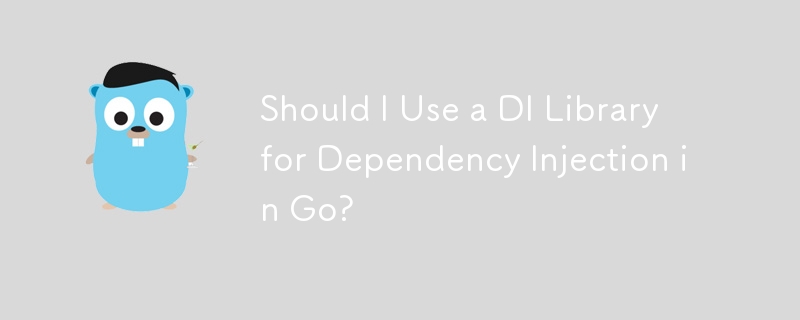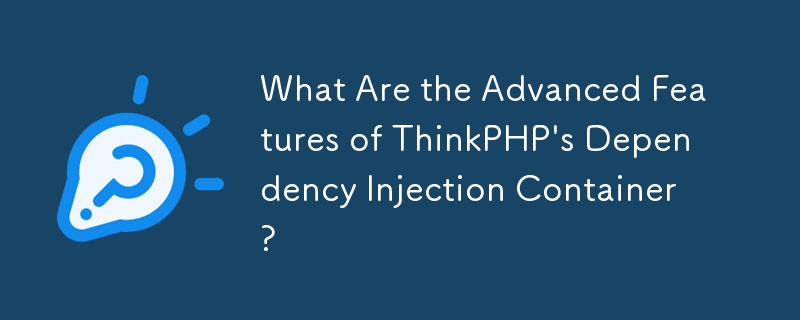Found a total of 10000 related content

Best Practices for Dependency Injection in PHP
Article Introduction:The reason for using Dependency Injection (DI) is that it promotes loose coupling, testability, and maintainability of the code. 1) Use constructor to inject dependencies, 2) Avoid using service locators, 3) Use dependency injection containers to manage dependencies, 4) Improve testability through injecting dependencies, 5) Avoid over-injection dependencies, 6) Consider the impact of DI on performance.
2025-05-08
comment 0
982
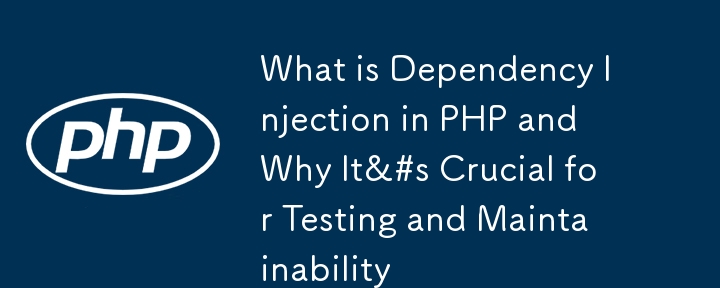

How to Build Your Own Dependency Injection Container
Article Introduction:This article discusses how to build a simple dependency injection container (DI container) PHP package. All code in the article, including PHPDoc annotations and unit tests (100% code coverage), has been uploaded to the GitHub repository and listed on Packagist.
Key points:
Building DI containers helps developers understand the basic principles of dependency injection and the working mechanism of containers.
DI containers have two main functions: "dependency injection" and "container". It needs to be able to instantiate and include services using constructor injection or setter injection methods.
Symfony dependency injection containers can be used as a reference for creating custom containers. It divides container configuration into parameters and services, allowing secure storage
2025-02-15
comment 0
891

PHP Dependency Injection Container Performance Benchmarks
Article Introduction:Key Takeaways
Dependency Injection Containers (DIC) are a key tool for maintaining codebases in larger PHP applications and frameworks, but can impact performance. Some of the well-known DICs for PHP include PHP-DI, Symfony\DependencyInjection, Ze
2025-02-20
comment 0
622
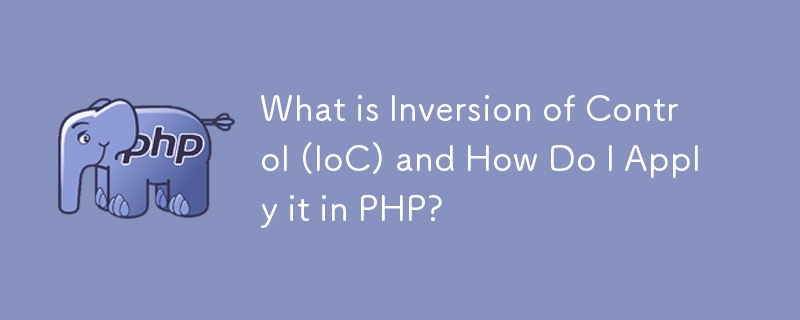
What is Inversion of Control (IoC) and How Do I Apply it in PHP?
Article Introduction:This article explains Inversion of Control (IoC) in PHP, a design principle where dependency creation is managed externally, promoting loose coupling. It details IoC implementation via manual dependency injection and service containers, highlighting
2025-03-10
comment 0
646

Dependency Injection for PHP: a quick summary
Article Introduction:DependencyInjection(DI)inPHPisadesignpatternthatmanagesandreducesclassdependencies,enhancingcodemodularity,testability,andmaintainability.Itallowspassingdependencieslikedatabaseconnectionstoclassesasparameters,facilitatingeasiertestingandscalability.
2025-05-11
comment 0
906

How to Implement Dependency Injection in PHP
Article Introduction:Implementing dependency injection (DI) in PHP can be done by manual injection or using DI containers. 1) Manual injection passes dependencies through constructors, such as the UserService class injecting Logger. 2) Use DI containers to automatically manage dependencies, such as the Container class to manage Logger and UserService. Implementing DI can improve code flexibility and testability, but you need to pay attention to traps such as overinjection and service locator anti-mode.
2025-05-07
comment 0
1126

Dependency Injection in PHP: Code Examples for Beginners
Article Introduction:You should care about DependencyInjection(DI) because it makes your code clearer and easier to maintain. 1) DI makes it more modular by decoupling classes, 2) improves the convenience of testing and code flexibility, 3) Use DI containers to manage complex dependencies, but pay attention to performance impact and circular dependencies, 4) The best practice is to rely on abstract interfaces to achieve loose coupling.
2025-05-14
comment 0
847
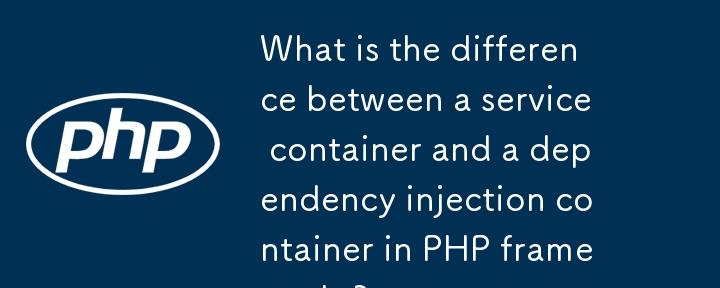
What is the difference between a service container and a dependency injection container in PHP frameworks?
Article Introduction:Service containers and dependency injection containers are often mentioned in the PHP framework. Although they are related, they are different. Dependency injection containers (DICs) focus on automatically parsing class dependencies, such as injecting objects through constructors without manual instantiation. The service container extends its functions on this basis, including binding interfaces to specific implementations, registering singletons, managing shared instances, etc. When using it, if the class dependency resolution or cross-frame scenarios are discussed, it should be called DIC; if it involves service management within the framework, it is called a service container. The two are often integrated in modern frameworks, but understanding their differences can help to gain a deep understanding of the framework mechanism.
2025-06-04
comment 0
814
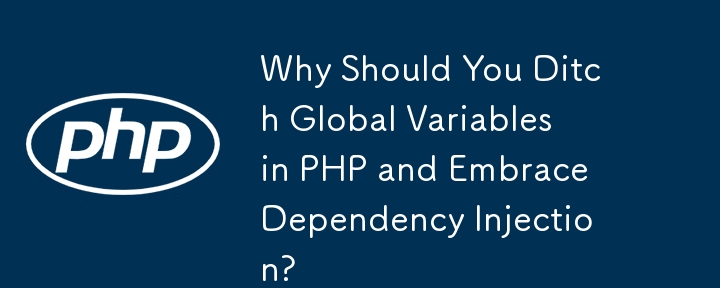

PHP Attributes (Annotations):?Usage and examples.
Article Introduction:PHP 8 introduces attributes, enhancing code readability and maintainability over PHPDoc comments. They're used for routing, validation, serialization, logging, and dependency injection in frameworks.
2025-03-25
comment 0
516

Explain Dependency Injection in Java frameworks like Spring.
Article Introduction:Dependency injection (DI) is a design pattern that enables loose coupling of code by externally managing dependencies of objects. Its core lies in injecting object dependencies from the outside rather than internal creation, thereby improving flexibility and maintainability. For example, in the UserService, pass into the UserRepository instance through the constructor, that is, the constructor injection. Spring framework supports multiple injection methods through IoC containers: 1. Constructor injection, suitable for forced dependencies; 2. Setter injection, suitable for optional dependencies; 3. Field injection (@Autowired), using annotations directly in fields. Advantages of DI include: decoupling, enhanced testability, flexible configuration, and easy maintenance. In practical applications, you need to pay attention to: avoid
2025-07-05
comment 0
650

How does dependency injection improve code testability and maintainability in PHP?
Article Introduction:Dependency injection (DI) makes PHP code easier to test and maintain by reducing tight coupling between components. Its core advantages include: 1. Simplify unit testing, allowing injection of simulated objects to replace real services, avoid side effects, and improve testing speed and reliability; 2. Promote loose coupling, making the class dependency interface rather than concrete implementation, making it easier to independently modify and expand components; 3. Improve reusability and configuration flexibility. The same class can achieve diversified behavior by injecting different dependencies in different contexts, such as the development, production and testing environments using different logging methods. In addition, modern PHP frameworks such as Symfony and Laravel built-in DI containers further simplify the implementation of object management and dependency injection.
2025-06-04
comment 0
515

How Does Dependency Injection Improve Testability in PHP?
Article Introduction:This article examines how Dependency Injection (DI) improves PHP testability. DI decouples classes, enabling easy mocking of dependencies for isolated unit testing. However, pitfalls like over-mocking and inconsistent DI implementation can hinder i
2025-03-10
comment 0
425

PHP Dependency Injection: Improve Code Testability
Article Introduction:Dependency injection (DI) significantly improves the testability of PHP code by explicitly transitive dependencies. 1) DI decoupling classes and specific implementations make testing and maintenance more flexible. 2) Among the three types, the constructor injects explicit expression dependencies to keep the state consistent. 3) Use DI containers to manage complex dependencies to improve code quality and development efficiency.
2025-05-12
comment 0
818

How Do I Write Testable PHP Code?
Article Introduction:This article details how to write testable PHP code. It emphasizes modularity, separation of concerns, and dependency injection to create loosely coupled, easily testable units. Best practices for unit testing, including the AAA pattern and mocking
2025-03-10
comment 0
638

Explain the concept of Dependency Injection (DI) in PHP.
Article Introduction:The core value of using dependency injection (DI) in PHP lies in the implementation of a loosely coupled system architecture. DI reduces direct dependencies between classes by providing dependencies externally, improving code testability and flexibility. When using DI, you can inject dependencies through constructors, set-point methods, or interfaces, and manage object lifecycles and dependencies in combination with IoC containers.
2025-04-05
comment 0
430

What is a Dependency Injection Container (DIC) and why use one in PHP?
Article Introduction:Dependency Injection Container (DIC) is a tool that manages and provides object dependencies for use in PHP projects. The main benefits of DIC include: 1. Decoupling, making components independent, and the code is easy to maintain and test; 2. Flexibility, easy to replace or modify dependencies; 3. Testability, convenient for injecting mock objects for unit testing.
2025-04-10
comment 0
449





